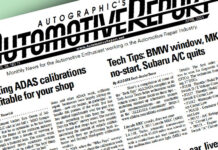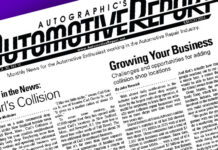By John Yoswick
You can’t talk with other shop owners or managers anywhere without gaining some good ideas that might work for your own shop. Here are some tips and perspectives from your colleagues around the country.
Differentiate your shop from larger ones
Eddie Patino said he’s turned competing against larger collision repair operations into an advantage for his seven-employee shop in Palm Desert, Calif.
“We tell potential customers that if you bring your car to a big body shop, you won’t even talk to someone who knows anything about the car,” said Patino of Unique Autobody & Paint. “You will call there and they have to look up your car by number. When you bring your car here, I explain the whole process. When you call, you can talk to me. Or we have a program where you can log in and see the progress on your car. Some people like that.”
Patino has used a variety of marketing means to attract work. The shop has a loaner car, for example, that has brought in some work from neighbors of customers who have seen it parked it in their neighbor’s driveway.
“We also do a lot of advertising on social media, Google and Facebook,” Patino said. “We hear from a lot of people that they found us on the Internet, or people say they heard our ads on the radio. I have a couple of ads on the radio.”
But like most small businesses, Unique Autobody relies heavily on word-of-mouth marketing from previous customers.
“We try to do the best job at the best price, so people recommend us,” Patino said. “You do a good job for them, and they tell people, ‘Go see Eddie.’ We keep the customers happy, and we pay well so the employees are happy and do a good job. I think everything starts right there. As soon as you have your employees happy, the jobs get better. Your people care more about the cars they’re repairing.”
Always saying ‘yes’ to customers
Joel Michelsen said Lithia Body & Paint of Bend’s move last year from a 4,000-square-foot shop at one of the company’s central Oregon dealerships to a new 13,000-square-foot shop is evidence of Lithia’s belief in the collision repair industry. Lithia has about 20 body shops at its new-car dealerships around the United States.
“I think the Lithia leadership that runs the body shop program and the fixed-ops program sees the value,” Michelsen, who has managed the body shop in Bend for Lithia for the past seven years, said. “We have meetings twice a year with all the managers from the shops, and you get a chance to really see what’s going on and feed off each other’s ideas. And part of my success here is that our general manager also sees the value of our department.”
Michelsen also said a commitment to great service and communication with customers drives up the shop’s business from repeat customers.
“We basically always say ‘yes’ and then figure out a way to get it done,” Michelsen said. “As we’ve done that over the years, I’m starting to see more repeat customers. I give credit to my crew. They all work together and they all go the extra mile. The painters will touch stuff up or polish stuff for people, and I have a technician who will do quick adjustments or repairs on vehicles for people at no charge. Those little things go so far. Any other shop I was out, it wasn’t done that way.”
Michelsen said one of his personal goals is to become better at not micro-managing his staff.
“I worked at a shop where I was micro-managed to death. It made me angry to the point that I left,” he said. “I look back at that and understand it more now, because that guy was the owner and it was his dollars. But I also try to empower my guys to make decisions, and not be afraid to make mistakes. Ultimately, we learn from our mistakes.”
Franchise works for family-run shop
For Pat and Tom Murray, a lot has come full circle. The two brothers each began their career working while still in high school at a body shop in Washington state owned by Robert Bjorneby.
Flash forward about 30 years to 2014, and the Murrays ended up buying Bjorneby’s business, renaming it Murray’s CARSTAR.
Today, Murray’s CARSTAR employs about 18 people, including seven family members. The shop had been a CARSTAR franchise prior to the purchase by the Murrays, and they have very positive things to say about their decision to continue as franchisees themselves.
“Being part of a group where you can learn and share ideas is the No. 1 thing,” Murray said. “No. 2, they have a fantastic platform in place to help us grow our business. All we have to do is follow it. In our area, the CARSTAR stores share marketing, so that’s very cost-effective. And CARSTAR has a great system you can use to track all your KPIs [key performance indicators], so it’s not difficult to know where we stand on a daily basis. We just love everything about it.”
One-of-a-kind facility
The clientele of the 40-employee World Class Collision in Palm Desert, Calif., consists largely of owners of the high-end vehicles for which the shop is certified to repair: Bentley, Rolls-Royce, Aston Martin, Porsche, Audi, Tesla and Jaguar and Land Rover.
But anyone walking through the shop that Jack Jackson designed and built might be hard-pressed not to use the “world class” descriptor for the facility itself. Nearly every element has been customized or crafted by Jackson in some way.
At the front of the shop, for example, a large enclosed area connected to the shop via multiple overhead doors serves as an estimating area and delivery “showroom” for completed vehicles. Jackson is installing a series of floor sensors in one section of this area that will track a vehicle coming into the shop for repairs.
“I devised this scanner with seven high-definition infrared cameras that will scan the [underside] of the vehicle as it drives in,” Jackson said. “I have tracks above where the car stops, and an arm will telescope down, then circle around to scan the upper part of the car, then lower more and circle around again to scan the bottom part of the car. All three videos will then be automatically be sent to the repair order, so we’ll know every scratch on every car when it comes in.”
Knowing your market
When Ron Doerr began running radio and television advertising for M&G Collision Specialists in Eugene, Ore., about three years ago, he emphasized a couple things that he thinks sets his shop apart from much of its competition: local family ownership, and a dedication to sound environmental practices.
“Here, if you’re not driving behind a Subaru, you’re driving behind a Toyota Prius, so using waterborne paint is part of what I mean when I say we’re as green as we can be,” Doerr said.
The shop made the switch to a waterbourne paint line, and Doerr said he couldn’t “believe how smoothly it went,” and how well color match meets or exceeds the solvent-based paint line the shop had been using. Production hasn’t suffered either, he said, with his two-man paint crew producing 850 to 1,000 hours a month.
Doerr said the shop also has long roots in the community, having opened in 1957. His father, Don (now retired), first painted at the shop, then bought the business in 1989 from the company founder. Ron’s sister also joined the business at that time as office manager. Ron worked in automotive paint sales before joining his father’s business in 1996. Local, family-ownership is becoming less common in the industry, Doerr said, and is something customers seem to appreciate.
Doerr says over the last several years he’s found radio and television advertising is effective, though it doesn’t reach everyone.
“The people who say ‘I heard or saw your commercial’ tend to be my age,” Doerr said. “They still get their news from the TV. The 18-35 age group? I’m still learning how to capture that. Our [online] reviews are pretty good. But my social media skills aren’t very good. That’s an area I think we need to work on as we continue to grow.”
Bring in outside help
If there’s one thing that most stands out in talking to Mark Martin about his business, Ankeny Autobody1 in Ankeny, Iowa, it’s the degree to which Martin has sought out business ideas and inspiration from outside the walls of his shop.
He’s participated, for example, in an AkzoNobel 20-group for about two decades. He’s hired a “social media coach” to handle the shop’s marketing efforts. He’s traveled to a shop in a neighboring state to study that company’s team production system. And he hired consultant Mike Anderson of Collision Advice for several months of assistance with a variety of business improvements. Those include overhauling some of the shop’s parts-related processes. Without a dedicated parts manager among his 12 employees, Martin said, no one is “really owning responsibility” for mirror-matching and other parts “best practices,” resulting in the need for a part too often not being determined until late in the repair.
“It was probably affecting cycle time really more than we thought it was,” he said.
Shift to ‘lean’ production
During more than a dozen years as a collision repair shop owner, Dustin Caldwell sometimes found his enthusiasm for the business waning.
“At times, I just allowed the insurance industry to kind of bully me and ruin my day,” said Caldwell, the second-generation owner of Old Dominion Collision Repair Center in Eugene, Ore.
That’s changed in recent years, he said, thanks to his involvement in a 20-group that enables Caldwell to regularly interact and compare business performance numbers with successful shop owners around the country.
“Every day I’m grateful for it,” Caldwell said. “I’m meeting with store owners who are really enjoying what they are doing, and who are profitable. I wasn’t even sure you could be profitable in this industry. But seeing it was possible, and based on the conversations we have at those meetings, I decided I just needed to be smarter and not let it get to me. It’s made it fun. It’s like a game of chess, figuring out how to strategically end up on the winning side of the equation.”
The Coyote Vision Group also helped cement his interest in the business’ financial numbers.
“I’d been more of a production floor guy, getting things done,” he said.
Caldwell now oversees a staff of 16, developing a “lean” production system, including a disassembly team who conduct a complete tear-down of the vehicle for a comprehensive repair order, with the vehicle then moving through metal, fill, refinish and reassembly stages.
The system uses a variety of visual and sound cues that signal, for example, when a vehicle is moving forward and thus another vehicle is needed in a given department within the shop.
Caldwell said the transition to the system in place today has not always been smooth. It actually was a visit to another shop running a lean production system that helped him get all the pieces into place. He even sent some members of his production team to tour that shop as well.
“They came back and knew we were close but needed a few solid tweaks,” Caldwell said. “We switched from a hourly pay system to a commission-based system as a team, for example. Within a month, our production went up by 30 percent. Now we’ve really hit our stride. We really have a team now, a bunch of guys who care about each other and are making things happen.” •
John Yoswick, a freelance writer based in Portland, Ore., who has been writing about the automotive industry since 1988, is also the editor of the weekly CRASH Network (www.CrashNetwork.com). He can be contacted by email at john@CrashNetwork.com.



